Vol 5 No. 21 TROPIC LIGHTNING NEWS June 8, 1970
Index
Blinded Pilot Lands LOH Safely
By SP4 WILLIAM L. MC GOWN
FSB SHARRON - “My plane’s shot up, my observer’s shot up and I can’t see.”
Enemy ground fire had shattered the windshield of the 25th Infantry Division
Artillery light observation helicopter (LOH), temporarily blinding the pilot,
Warrant Officer John M. Lanning, of New Orleans, with glass fragments and blood.
“We were flying over Highway 7 in Cambodia,” recalled Specialist 4 Robert W.
Tobey, of Portland, Ore. “As we neared a small village, we pulled up to pass
over a tree line - I guess our altitude was about 40 feet - when I heard several
shots.”
“Mister Lanning immediately banked to the right gaining altitude,” said Tobey.
“He leveled off, handed me the map and asked me to locate our position. I
noticed that his left eye was swollen shut and blood was streaming down over his
other eye.
“Then he called MAYDAY. He told me he could just barely make out the road,
and although we were following it, I couldn’t locate our exact position.”
About this time, Warrant Officer Terrian Bachi, of Battavia, La., arriving at
FSB Sharron, was notified that a Divarty helicopter had just been shot down.
The MAYDAY had come in on an FM radio.
“They had no knowledge of an exact coordinate,” said Bachi, “so I told them
that I knew the approximate location and took off. Before he went out, Lanning
told me where he was going and said, `If you don’t hear from me in 30 (minutes),
come look for me. ‘That probably saved his and the other two passengers’ lives.
“I was flying at top speed when I noticed a LOH approaching,” continued Bachi.
“It was Lanning.
“He told me ‘My plane’s shot up, my AO’s shot up, and I’m blind,’ then asked
me if the road was safe for landing.”
“ ‘Negative’, I replied, and asked if he could make it to Sharron - about two
miles. I then told him his altitude and air speed. He asked me to go ahead of
him and talk him on down.
“As we approached Sharron,” Bachi said, “I continued to inform him of his
ever decreasing altitude and air speed, so he could make the most basic and
gradual approach possible.
“As I passed over the landing zone I said, ‘This is it,’ then made a quick
turn to I could watch his approach. I frictioned down my controls as I talked
him on down: ‘You’re ten feet off the ground, five feet, four feet, three, two,
one. You’re left skid is touching, right skid is touching. You’re down!”
Recalling the incident later, Bachi commented, “It was one of the best
landings I’ve ever seen him make. I’m his Instructor Pilot and I was all the
time kidding about his landings. After that beaut’, I won’t kid him anymore.”
Run into Ambushers
NVA Escape to Trap
From SP4 ROBB LATO
THIEN NGON - The sudden fire of a 25th Division infantry company so startled
an enemy unit patrolling the Cambodian woods that the Communists ran straight
towards the American guns.
Five of them died. Eleven others were detained.
The men of Bravo Company, 2nd Battalion, 27th Infantry, according to
Specialist 4 Brian Klaus, of Windsor Locks, Conn., “were in a night position in
a wooded area (six miles north of Vietnam/Cambodian border in the “Dog’s Face”) and it was pitch dark.
Suddenly, we spotted about 16 enemy approaching our position.”
Waiting until the right moment, the company’s riflemen opened up from several
angles.
“They (the enemy) panicked and ran straight towards us,” said Company
Commander, Captain Charles Criswell, of Ft. Benning, Ga. “They didn’t know
which end was up.”
Besides killing five and taking 11 detainees, the GIs captured numerous small
arms, including one .30 caliber machine gun.
“I think the men should be commended for this ambush,” said Sergeant Edward
Striedl, from Brooklyn, N.Y. “Most of those involved in the fighting were from
our mortar platoon, who, under normal circumstances, really don’t see much
action.”
Warriors Capture Enemy Launcher
DAU TIENG - In an early evening encounter north of here recently, the 25th
Division “Warriors” of D Company, 2nd Battalion, 12th Infantry, captured one
enemy and one ready-to-be-fired RPG launcher.
According to medic, Specialist 4 Dennis Truscott, of Nephi, Utah, “We were in
a holding area and some of us were just starting to ‘chow down.’ I had gotten
to my feet to get a little more comfortable when I spotted movement among the
rubber trees in the distance.
“I had just enough time to give a warning when David Sheriff (Private First
Class, from Easley, S.C.) also spotted the movement, and identified a group of
from three to six enemy,” Truscott said.
Company Commander, Captain Byron White, of Rockwell, S.C., said, “It was kind
of a ticklish situation. The men got quickly into position but before we could
take action I had to double check on the location of another one of our elements
that was in search of night locations.
“Meanwhile,” he continued, “the enemy was moving in our general direction.
Confirmation wasn’t long in coming and we immediately opened up on the
group.”
“The terrain made it difficult for any real shooting accuracy,” White said.
“We dropped only one and the rest scattered. However, he later proven to be the
jackpot.”
After checking for movement in the kill zone and searching out the area, the
GIs found the wounded enemy. He was armed with a rocket propelled grenade
launcher and two B-40 rounds.
Commenting on the find, artillery recon sergeant, Mike Hill, of San
Francisco, said, “The launcher was in great shape. Although there were only two
rounds found, one of them was in the launcher, ready to be fired.”
Following the action, the Warriors rigged up a stretcher from a donated
poncho liner and transported the injured enemy some one thousand yards in the
darkness to be dusted off.
The injured man, according to White, later revealed “a gold mine of
information.”
Bobcats Hit Foes’ Commo
By SP4 RICH FITZPATRICK
TAY NINH -- “Before Cambodia, all we saw of enemy communication was hand
carried messages. This is unbelievable.”
So spoke 1st Lieutenant John K. Layne, of Belmont, N.C., as he surveyed the
enemy radio complex found by the 25th Division’s Alfa Company, 1st Battalion
(Mech.), 5th Infantry.
The 1/5th “Bobcats” came across the cache two and one half miles inside
Cambodia, due north of Nui Ba Den.
First Sergeant Arcadio Torres, of Mt. Holly, N.J., recalled how Alfa found
the site: “We’d come across dozens of bunkers and fighting positions that
morning. One of the men was routinely checking out another hole and found some
radio parts and a telephone with wire attached.”
As the Bobcats followed the wire they came across an entire “commo”
workshop. One area contained so many parts and partially completed radio sets
that Specialist 4 John A. Mack, from Windsor Locks, Conn., remarked, “It seems
like `Charlie’ had a regular assembly line.”
Continuing the search, the Americans found hand-cranked electrical
generators, telephones, a case of batteries, telegraphic equipment and numerous
radio receivers and transmitters.
The area was not only used for construction but also for instruction. A
classroom complete with charts and diagrams explaining how to maintain the radio
sets was found.
“It seems like Communists have ‘PM’ (Preventive Maintenance), too,” commented
one of the GIs.
The idea that this was a major base camp was strengthened by the find of
typewriters and tape recorders.
Included in day’s find were 15 tons of rice, medical supplies and a few small
arms.
“This was obviously a major communication center,” commented Lieutenant
Colonel Ted G. Westerman, battalion commander from Chicago, “Destruction of the
equipment and taking the rice will be a serious setback for the enemy.”
Not all the equipment was destroyed however. The men of one Alfa Company
track picked up a captured radio handset and are using it on their track radio.
“It works great, and took a lot less red tape than normal supply channels
would have,” explained Specialist 4 Gene R. Handorf, of Lowden, Iowa.
|
It’s Super P-38 |
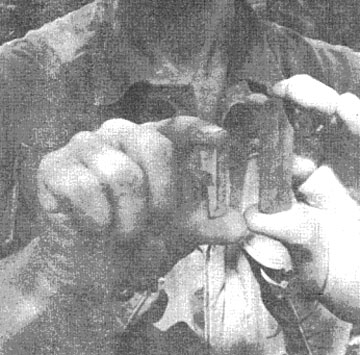 |
| NEAR THE DOG’S FACE - GI’s in the field beware - the famous hand-held,
air-cooled, can-fed P-38 opener is now in the hands of the enemy. The device,
used world-wide by U.S. armed forces, usually operates below C-level. A communist version of the P-38 was recently uncovered by Bravo Company, 2d Battalion, 14th Infantry, while operating in Cambodia just south of the Dog’s Face region. The design has been modified by enemy technicians who use heavy brass instead of light-weight alloy. Also the smooth curves - probably thought to be too bourgeois - were changed to stark, straight lines in keeping with Chairman Mao’s philosophy. Although the P-38 is as American as apple pie, the enemy version was probably acclaimed throughout the Communist world as another “first” along with the telephone and the electric light bulb. All is not lost however. Initial intelligence reports indicate that the Chi-Com P-38 presents no breach in national security and should have no effect on the war effort in Southeast Asia. |
Page 2 TROPIC LIGHTNING NEWS June 8, 1970
Decorated
| SILVER STAR | |
| CPT Leland W. Potter, Co C, 2d Bn, 22d Inf CPT Lawson R. Pride Jr, Co C, 3d Bn, 22d Inf 1LT Robert Sees, Co C, 2d Bn, 22d Inf 2LT Gail Keller, Co A, 1st Bn, 5th Inf SSG Edward Cote, Co A, 1st Bn, 5th Inf SGT Edward P. Striedl, Co B, 2d Bn, 27th Inf |
SP5 David A. Faiello, Co A, 2d Bn, 12th Inf SP4 James A. Bindhammer, HHC, 3d Bn, 22d Inf SP4 Steven Farrell, Co C, 2d Bn, 22d Inf SP4 Richard D. Nast, HHC, 2d Bn, 27th Inf SP4 Armando Noriega, Co B, 2d Bn, 27th Inf SP4 Fredrick E. Phillips, HHC, 2d Bn, 22d Inf |
| DISTINGUISHED FLYING CROSS |
|
| CPT Chrisman E. Bonnell, HHC, 3d Bde CW2 Daniel V. Kelley, Co A, 25th Avn Bn WO1 Richard H. Reed, D Trp, 3d Sqdn, 4th Cav WO1 Alfred N. Ziolkowski, Co A, 25th Avn Bn |
SGT Terry L. Dildy, D Trp, 3d Sqdn, 4th Cav SP5 Steven L. Dobry, D Trp, 3d Sqdn, 4th Cav SP5 Joe D. Ramey, D Trp, 3d Sqdn, 4th Cav SP4 Loroy M. Sanderson, D Trp, 3d Sqdn, 4th Cav |
| SOLDIER'S MEDAL |
|
| CPT Leland W. Potter, HHC, 2d Bn, 22d Inf 1LT Timothy P. Jachowski, Co A, 2d Bn, 12th Inf 1SG Rudolph V. Chandler, B Trp, 3d Sqdn, 4th Cav SGT John Rains, A Btry, 2d Bn, 77th Fld Arty SGT Frank J. Viscomi Jr, Co A, 2d Bn, 12th Inf |
SP5 Carlos Garcia, Co C, 725th Maint Bn SP4 Edward S. Brim, C Trp, 3d Sqdn, 4th Cav SP4 David A. Faiello, Co A, 2d Bn, 12th Inf SP4 Luther D. Shelton, Co C, 2d Bn, 22d Inf SP4 Terry J. Sperry, C Trp, 3d Sqdn, 4th Cav |
| BRONZE STAR FOR VALOR |
|
| MAJ Howard L. McAllister, HHC, 2d Bn, 27th Int CPT Anthony A. Moreno, Co A, 2d Bn, 12th Inf CPT Joseph M. Murphy, Co A, 2d Bn, 14th Inf CPT Terrence E. O’Hara, Co C, 4th Bn, 23d Inf CPT Anthony V. Rodrigues, HHC, 3d Bde 1LT Joseph E. Carr, Co A, 2d Bn, 34th Armor 1LT Ronald Henderson, Co C, 3d Bn, 22d Inf 1LT Dennis R. Horn, A Btry, 7th Bn, 11th Fld Arty 1LT Harry B, McCarthy, Co A, 2d Bn, 34th Armor 2LT Michael J. Reker, A Btry, 7th Bn, 11th Fid Arty SFC Thomas D. Clark, HHC, 2d Bn, 34th Armor SFC John H. Flacker, HHC, 2d Bn, 34th Armor SSG William H. Albert, Co A, 2d Bn, 14th Inf SSG James E. Cameron, Co A, 2d Bn, 34th Armor SSG Emil M. Dular, HHC, 2d Bn, 34th Armor SSG Ronald P. Duran, A Btry, 7th Bn, 11th Fld Arty SSG James Higginbotham, Co A, 2d Bn, 34th Armor SSG Willie H. Porter. Co C, 3d Bn, 22d Inf SSG David L. Roberts, A Btry, 7th Bn, 11th Fld Arty SSG Wayne H, Singletary, A Btry, 7th Bn, 11th Fid Arty SSG James C. Smith, HHC, 2d Bn, 34th Armor SSG Claude E. Tarver, A Btry, 7th Bn, 11th Fid Arty SGT Stephen R. Adams, Co B, 2d Bn, 27th Inf SGT William J. Campbell Jr, Co A, 2dBn, 12th Inf SGT John E. Dahlstrom, A Btry, 7th Bn, 11th Fid Arty |
SGT James J. Davis, Co B, 2d Bn, 34th Armor SGT William A. Fischer, Co A, 2d Bn, 23th Inf SGT Charles G. Jacobson, Co B, 2d Bn, 34th Armor SGT Wallace B. Martin, A Btry, 7th Bn, 11th Fld Arty SGT William A. Morton, Co A, 2d Bn, 12th Inf SGT Joseph S. Rubio, Co B, 2d Bn, 27th Inf SGT Victor, S. Stanley, Co A, 2d Bn, 34th Armor SGT Robert M. Swadish, Co A, 2d Bn, 34th Armor SP5 Michael Dunstan, HHC, 2d Bn, 34th Armor SP5 Robert L. Renforth, HHC, 2d Bn, 34th Armor SP5 Frank Wolford, Co A, 2d Bn, 34th Armor CPL Eugene White, A Btry, 7th Bn, I 1 th Fld Arty SP4 Alexander Almasi, HHC, 2d Bn, 34th Armor SP4 Larry Bentley, HHC, 3d Sqdn, 4th Cav SP4 John T. Berger, HHC, 3d Bn, 22d Inf SP4 Roy D. Brigham, Co A, 2d Bn, 12th Inf SP4 David Callaghan, HHC, 2d Bn, 34th Armor SP4 Eddie J. Cross, HHC, 2d Bn, 34th Armor SP4 David T. D. Erickson, Co A, 2d Bn, 12th lnf SP4 Brian S. Felrath, HHT, 3d Sqdn, 4th Cav SP4 Stanton L. Flory, HHS Btry, 7th Bn, 11th Fld Arty SP4 Douglas E. Goularte, Co B, 2d Bn, 34th Armor SP4 James F. Harvey, Co A, 2d Bn, 34th Armor SP4 James L. Jensen, HHC, 2d Bn, 34th Armor |
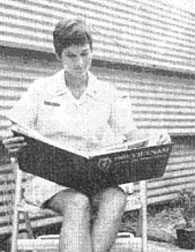 |
VERY GOOD YEAR -- Donut Dolly Pam reviews last year’s action in the 25th Division as she reads the Division Yearbook, just out. Copies are available at the Division Information Office in Cu Chi. (Photo by SP4 Bert Herrman) |
Gruntnamese Is Beaucoup Numbah One
By SP4 RICH DOMBROWICKI
CU CHI - “After riffing all day with a duper, I had beaucoup chop-chop and
crashed in my hootch.”
Newcomers to Vietnam have many things to get accustomed to, including
weather, water and the country itself. Another facet of life here is the
language - GI type.
To make the “funoogy” (newcomer) feel more at home, we offer a partial list
of “Gruntnamese” terms commonly used in Tropic Lightning Country.
1) same-same - same as
2) tee-tee -- small amount
3) beaucoup -- large amount
4) Donut Dolly - Red Cross girl
5) numbah one - the best
6) numbah ten -- the worst
7) crash - sleep
8) hootch -- living quarters
9) chop-chop – food
10) the horn – radio microphone
11) the world - the United States
12) didi mau - leave an area quickly
13) bic – understand
14) charm school - 25th Division replacement training
15) mad minute – night display of massive firepower
16) Freedom Bird – no explanation needed
In tee-tee time the funoogy will bic Gruntnamese. But How’ya gonna talk to that
freedom bird stewardess?
| Lieutenant Colonel Edward M. Bradford, Vienna, Va., has taken command of the 4th Battalion, 23rd Infantry “Tomahawks. LTC Bradford previously was assigned to the 1st Brigade, 25th Infantry Division, as executive officer. |
 |
Tropic Lightning Tots
The Commanding General Welcomes
The Following Tropic Lightning Tots
To The 25th Infantry Division – As
Reported By The American Red Cross.
Born To:
| Apr 27 1LT Roger Lorenz, C Co, 65th Engr Bn, 25th Inf, girl Apr 29 SP4 Clarence Hunter Jr., 25th Admin Co, girl Apr 30 SFC William Sharon, 25th M.P. Co, girl May 3 PFC Richard D. Novak, Btry A, 2nd Bn, 32nd Inf, boy WO1 James N. Seals, 159th Med Bn, 25th Inf Div, girl SGT Gary Lee Johnson, B Co, 4th Bn, 9th Inf, boy May 7 WO1 Leroy D. Allen, HHC, 259th boy PFC Antonio L. Andres, Trp C, 2/4 Cav, girl PFC Michael Jerkebek, C Co, 4th Bn, 9th Inf, boy May 8 SP4 Peter J. Maczik, 44th IPSD, girl May 10 PVT Ronald Sayers Jr., LCLC, 25th Inf Div, boy SP4 Williams D. Jones, A Co, 4th Bn, 23d Inf, girl |
May 12 SGT Terry A. Fisher, 25th Replacement, boy May 14 SP5 James A. Tucker, HHC, 1st Bde, girl CPT William Beane, D Co, 25th Med Bn, girl May 15 SP4 David E. Carter, C Co, 725th Maint Bn, girl May 16 1LT A. F. Renaud, 187th Avn Bn, boy May 17 CPT Edward L. Elrich. 45th Surg., girl May 18 SP5 Leo H. Duaberman, Hq Co, 25th Inf Div, girl May 19 SP4 Harry J. Russard, 579th Sig Co, boy |
The TROPIC LIGHTNING NEWS is an authorized publication of the 25th Infantry Division. It is published weekly for all division units in the Republic of Vietnam by the Information Office, 25th Infantry Division, APO San Francisco 96225. American Forces Press Service and Army News Feature materials are used. Views and opinions expressed are not necessarily those of the Department of the Army. Printed in Tokyo, Japan, by Pacific Stars and Stripes.
MG Edward Bautz, Jr . . . . Commanding General
MAJ Warren J. Field . . . Information Officer
1LT John Caspari . . . . . . . Officer-in-Charge
SSG Stephen F. Veroczi . . NCOIC
SP4 Charles C. Self . . . . . . Editor
SP5 Gary D. Sciortino . . . Assistant Editor
SP4 Joseph V. Kocian . . . Production Supervisor
BATTALION CORRESPONDENTS
| SGT Bill Oberholzer SGT Wally Baker SP4 Jim Williams SP4 Greg Stanmar SP4 Doug Sainsbury SP4 Ken Barron SP4 Greg Duncan SP4 Brad Yaeger SP4 Frank Rezzonico SP4 Dan Neff SP4 William McGown |
4/23 2/34 2/12 2/14 2/77 1/8 2/27 1/27 1/27 7/11 Divarty |
SP4 Henry Zukowski,
Jr. SP4 Joe O'Rourke SP4 Ray Byrne SP4 Robert Caplan SGT William E. Zarrett SP4 Brian Flaherty SP4 Rich Fitzpatrick PFC Rob Lato SP4 Frank Salerno SP4 Lawrence Merritt |
2/22 3/4 2/14 4/23 4/9 2/22 1/5 2/27 2/22 4/9 |
Page 3 TROPIC LIGHTNING NEWS June 8, 1970
‘Stalking Rhinos’
They Eat Hearty Chow
By SP4 JOE O’ROURKE
What do “Stalking Rhinos” eat for breakfast? The 25th Infantry Division’s
3rd Squadron, 4th Cavalry, has the menu.
They start with an appetizer of a little GAA for the road wheels, then a nice
10-weight oil transmission dressing.
The main course is diesel fuel, with a little 30-weight oil to garnish the
engine. Finishing up, the “Rhinos” have a couple of quarts of Cherry Juice to
keep the main gun kicking. For between-meal snacks an assortment of nuts, bolts, and track sections are served.
Ruggedly built. and every bit as bad-tempered and swift as its animal
counterpart this mechanized pachyderm has quickly become a cherished weapon is
the 25th Infantry Division and a source of pride to the 3/4 Cav’s Sheridan crews
who have dubbed their vehicles and themselves, “Stalking Rhinos” - complete with
Rhino patches.
The Sheridan is armed with a 152mm main gun, the M-16’s and M-79’s that the
crew members carry, at least one .50 cal. machinegun, a 7.62mm coaxially-mounted
machinegun and a full salvo of grenade launchers mounted on the turret.
Former Line Trooper Jazzes Up the Army
By SP4 GREG STANMAR
An eleven bush fighting the war with a guitar?
That’s the way it is with Specialist 4 Edward Perkins, New Orleans, La. He’s
with Special Services and tours Vietnam with a jazz group going “to the small,
out of the way places. You know, where the big USO shows can’t go but where
they really need the entertainment,” said Perkins.
“One day I walked into the Service Club here (Ilikai East) while on stand
down,” said the musician. “They had this talent contest. Well, I played with
this jazz group in New Orleans, Pogy Jones Plus Three, and I never got fired.
So I figured I’d give it a try.”
He won that contest and he kept on winning in shows until he was given a
60-day tour. After that he went to work with USARV Special Service still on
tour.
“It’s out of sight the way the guys show their appreciation,” said Perkins.
“I guess they like to hear an American Group. Our shows last 2 1/2 hours and we
throw a little bit of everything at them. If we’re really turned on by the
response we play longer.”
Perkins now goes to Saigon to plan other performers’ shows. “After all,” he
said, “even a musician gets short.”
| TIJUANA BRASS? -- No, it’s not Herb Alpert. It is the 25th Division Band getting a lift on the “Tomahawk” tracks of Headquarters Company, 4th Battalion (Mech.), 23rd Infantry. (Photo by SP4 Robert C. Caplan) |
 |
Witty Warriors Win Club Girls
By SP4 BERT HERRMAN
CU CHI - Four GI’s got a big boost to their dating life in Vietnam, when Ilikai East Service Club ran their version of “the Dating Game.”
Two Special Services girls and two donut dollies offered an evening to the
guys with the right answers to their questions.
“I like sweet, romantic things,” cooed sexy Gail Sanders of the Service
Club. “How are you going to impress me?”
“Southern Charm,” answered one Wolfhound. Another contestant suggested,
“poetry and flowers.” The Wolfhound even tried to impress Gail with an imitation
of Jerry Lewis, which put the audience in stitches. But it was to no avail;
Gail chose Specialist 4 William McGown of DIVARTY HHB, from Dallas, Tex., who
sang a line of a Dean Martin song.
Donut Dolly Vivian Hayes gave herself to the Golden Dragon who offered a
reading of “Mary Had a Little Lamb.” Specialist 4 Curtis Cooper, C Company, 2nd
Battalion, 14th Infantry, was very happy about the whole thing.
Specialist 4 Tom Burgess from Spokane, Wash., of the 65th Engineers, who won
leggy Terry Tucker of the service club, said that more than the complementary
supper at the Chinese restaurant, he was looking forward to being with a real
round-eyed girl.
Donut Dolly Peggy Lynd said she was scared to death from the guys eyeing her
as she walked down the aisle to the stage all dolled up. “I would have felt
safer in my uniform.” Her date was Specialist 4 Richard Cofe, D Company, 588th
Engineers, from Montreal Canada.
More than 200 men turned out to watch or take part in the game; there were
plenty of laughs as the guys and girls on stage tank turns getting embarrassed.
First Lieutenant Hugh Wilson was the master of ceremonies.
| A CLOSE SHAVE -- After a day of patrolling a trooper of the 3rd Squadron, 4th Cavalry, uses his field expedient shaving kit as he cleans up. (Photo by SP4 Joe O’Rourke) | 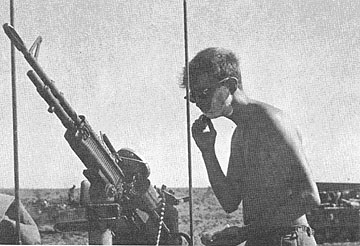 |
Sleeps When He Can
Arty Gunner’s Life is Hard
By SP4 TOM BENN
TAY NINH - For Specialist 4 Tim Tynan, Vietnam is the place where he does his
job for the United States Army, a place and a job that are both from home.
Specialist Tynan is not an unusual soldier and his job is not extraordinary.
He is the assistant gunner on “Gun Three,” at Charlie Battery, 7th Battalion,
11th Artillery.
Being the assistant gunner means that Tynan is the man who actually fires the
gun, which in his case is a 105mm howitzer. He has the added responsibility of
making sure that the seven-man gun crew thoroughly cleans the howitzer every
morning.
Tynan’s day never really begins or ends. As an artilleryman, he lives in
24-hour cycles and catches sleep when he can, usually for two or three hours at
night and a few hours sneaked in during the afternoon.
When he’s not “crashing,” Tynan spends his spare hours as most GIs do,
reading and writing letters, showering and rapping with his buddies.
Tynan’s Vietnam experience will be over soon. He is already in his
thirteenth month here and has extended so he can ETS when he hits American
soil. Looking back, the thing he says he dislikes the most about Vietnam is the
heat and humidity.
“It can really get to you,” he commented.
Likewise, nighttime was the thing he liked best because “at least it’s cool
then.”
Reflecting on his year here, Tynan remarked of the rainy season, “That’s
something I don’t want to go through again. You’re sitting in a nice dry bunker
and you’ve got to come out into the pouring rain for a fire mission.
“Then you’ve got to wait for air clearance (permission to fire). It
sometimes takes 15-20 minutes and you’re just standing out there. Then you get
the call, ‘End of mission’ and everybody’s teed off.”
But then Tim Tynan shrugged and said, “But I guess it was kind of fun,
looking back at it now.”
 |
MOBILIZING -- Men of the “Battlin’ Bravo” of the 4th Battalion (Mech.), 23rd Infantry “Tomahawks” move out on their armored personnel carriers. The unit recently went into Cambodia in search of enemy sanctuaries there. (Photo by SGT Bill Oberholzer) |
Page 4-5 TROPIC LIGHTNING NEWS June 8, 1970
NVA RICE FOR
REFUGEES
By SP5 STEPHEN F. KROFT
Some elements of the 25th Infantry Division have been wrestling
with the problems of success the past few weeks. Specifically, what to do
with hundreds of tons of enemy rice recovered from Communist sanctuaries in
Cambodia.
The rice must be transported to warehouses in Tay Ninh where it
will be used as a quick reaction food source for thousands of Vietnamese
refugees.
Units locating rice caches have been loading trucks and APCs with
the bulky 200-pound bags of grain and moving 20 to 30 tons a day to battalion
resupply points. The rice is then trucked to brigade collection points at
Thien Ngon and Katum, and back to Tay Ninh by convoy.
All available resources have been pressed into service. The
3/4 Cav has been employing native Cambodians to load trucks and even the
division band has been hauling rice.
|
Photos by |
|
Rice found in Caches like this... |
 |
 |
...were carried by hand... |
|
..and loaded on trucks... |
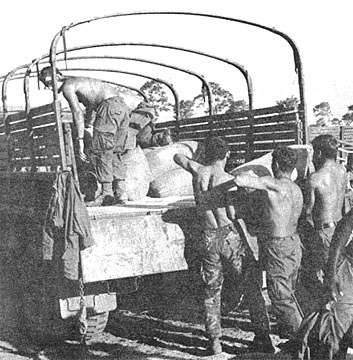 |
 |
...or evacuated by tracks... |
 |
|
... to stockpiles like this one at Tay Ninh... |
 |
...and carried to distribution points... |
|
... to feed children... |
 |
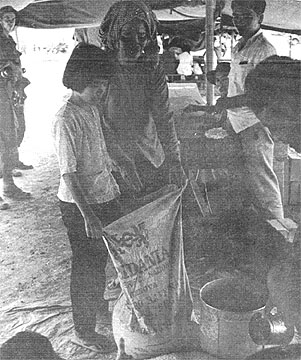 |
...and families left homeless by the war. |
Page 6 TROPIC LIGHTNING NEWS June 8, 1970
Won’t Go Away
Weather forecast: Rain until November
BY SP4 RICH DOMBROWICKI
CU CHI - Upon arriving in the Republic of Vietnam, one of the first things
one notices is the climate and weather. It ain’t like it is back home.
In order to gain a better understanding of the climatic situation, this
reporter “humped” down to Operating Location 4 which is next to the passenger
terminal of Cu Chi’s airport.
Here, in “climate-controlled” comfort, the U.S. Air Force’s 5th Weather
Squadron observes and forecasts the weather picture for the 25th Infantry
Division’s area of operations.
Q. Now, what’s this about a monsoon?
A. (Captain Leonard Bucklin, 5th Weather Squadron commander, Providence,
R.I.) Technically speaking, a monsoon is a seasonal wind. However, it is
commonly known as the wet season here. This is when winds blow from a
southwesterly direction originating over the Indian Ocean. Moisture picked up
from the ocean by the winds, combined with that picked up from the South China
Sea, is dropped on the southern half of South Vietnam.
Contrastingly, when the winds blow from a northeasterly direction, by the
time the rain clouds reach us, all their moisture has been deposited on the
northern half of Vietnam, mostly in the mountainous Central Highlands. So our
dry season is their wet season and vice-versa.
Q. How long does the wet season last?
A. (Bucklin) It lasts from late May to early November.
Q. Does it rain everyday?
A. (Bucklin) Yes. Most of the day’s rain falls between 2 p.m. and 10 p.m.
Q. So, those people who DEROS before next November have seen their last day
of total sunshine?
A. (Bucklin) Right.
Q. How much rain does Vietnam receive?
A. (Bucklin) Rainfall during the wet months measures about 78 inches, a 300
per cent increase compared to the dry season. Vietnam averages 84.3 inches a
year. The state of Virginia, by comparison, gets 45 inches annually.
Q. What about the humidity?
A. (Tech/Sergeant Barry Golembiewski, Reading, Pa.) During the wet season,
the humidity is highest during the early morning. It will average about 90 per
cent. When it is raining it drops to 60 per cent.
Q. I’ve heard that the winds make the rain fall sideways. True?
A. (Golembiewski) Vietnam’s thunderstorms usually pack high winds. Winds
with speeds as high as 60 knots (72-75 mph) have been recorded. How does that
grab you? Usually, though, winds average about 10 knots (15 mph) each day.
Q. And temperatures? Guys have told me that it hits 120 degrees at times.
A. (Golembiewski) A common thermometer in the broiling sun will record a lot
higher than it actually is. The high for Cu Chi is 103 and Tay Ninh’s highest
ever is 106. It may feel a lot hotter but, believe it or not, it isn’t.
Although temperatures average 10 degrees less during the wet season, January
is the “coolest” month with an average low of 63 at 7 a.m. or so. Incidentally,
the Central Highlands are always 20 degrees cooler than Cu Chi.
Q. How can the AFVN weather girl stand there and say that Saigon only had 86
degrees when we were baking that same day?
A. (Bucklin) Saigon receives the benefits of cooling coastal breezes all day
long. We get them between 5 p.m. and 7 p.m. every day. That’s when the winds
always pick up, if you’ve ever noticed.
So, with a better insight into the weather of Vietnam, I thanked the 5th
Weather Squadron and reluctantly left the air-conditioned office for the
“glorious” sunshine of this tropical paradise.
Oh, by the way, for those of you who thought that April was an extremely hot
month, you were extremely right. April is the hottest month of the year in
South Vietnam.
| The Division Yearbook, Vietnam 1969 is now available at the Division Information Office. The book is $5.00 a copy. If preferred the book can be sent to you. Please send $5.00 in check or money order to: Information Office, Headquarters, 25th Infantry Division, APO In Country 96225. Prepaid copies of the Yearbook are now in the mail. |
Monsoons Maul; Hounds Overhaul
FSB CHAMBERLAIN - With the rainy season fast approaching, living conditions
at support bases undergo many changes in order to keep the infantrymen as high
and dry as possible.
Although it is impossible to stop the rain, men of the 2nd Battalion 27th
Infantry Wolfhounds have taken steps to keep its effects to a minimum.
At Fire Support Base Chamberlain members of Headquarters Company began making
some improvements after a recent heavy rainfall.
“We had to dig some new ditches and improve some old ones in order to keep
the roads and higher ground as free from mud as possible,” explained Sergeant
Daniel G. Pollock from Austin, Colorado.
Bunkers also needed some overhauling.
“My first night out here the rain poured through my bunker roof like a
waterfall,” complained Specialist 4 Tom Adams from Warwick, R.I.
“Everything I own got soaked. I spent most of the next day fixing the roof,
and now it seems to be pretty tight. At least, I sure hope so,” added Adams.
At the Sugar Mill near Hiep Hoa, members of B company also had their
problems.
“Not only did just about everyone’s gear get soaked, but the wind was blowing
out windows, and one guy was even hit on the head by a large screen and had to
be dusted-off,” said Specialist 4 Ed Harper from Kennewick, Wash.
When the rainy season arrives, nothing can be done except to make the best of
it. However, some of the 2nd Wolfhounds have been heard singing “Rain, Rain Go
Away,” and doing a funny little dance.
|
ILIKAI EAST BY NIGHT: |
||||
|
Ask SGT Certain
DEAR SGT CERTAIN: Does the 25th Infantry Division have any organized athletic
competitions?
Athletic Sam
DEAR SAM: Funny you should mention this. In a few weeks the Third Annual SGT
Certain Monsoon Season Steeplechase Swimming Meet will be held. Events include
an underwater scavenger hunt in flooded scrow ditches, mud wading in full field
gear and a leaping contest in which contestants will jump into three feet of mud
which they will have thought was hard ground. Once the rain begins, runoffs
will be held everywhere.
Page 7 TROPIC LIGHTNING NEWS June 8, 1970
 |
 |
PM
By SP4 RICH FITZPATRICK
DAU TIENG - “What we need around here is a little more PM,” said Chief
Warrant Officer Billy C. Wood of Lafayette, La., logistics section leader for
the 1st Battalion (Mech.), 5th Infantry.
He wasn’t referring to more night life - he was talking about Preventive
Maintenance.
“PM is just what it says,” Wood explained. “It is maintenance the individual
can do that stops the need for more difficult repairs later.”
“Sure I clean my ‘16 every day. I don’t take any chances. It’s my ticket
home,” said Specialist 4 William Green of Daly City, Calif., a rifleman with
Alfa Company.
“Every couple of weeks I spend a couple of hours cleaning my magazines. I
want to make sure that when I need my weapon, rounds - not mud - will be going
down the barrel,” added Specialist 4 Doug Middleton of Glennie, Mich.
“None of my men ever have to be told to clean their weapons,” said 1st
Lieutenant Albert C. Flagg Jr. of Albans, Vt., 2nd platoon leader in Bobcat
Bravo. “They know their lives ride on how well their weapons work.”
Specialist 4 William Hartley Jr. of Edgefield, S.C., a .50-caliber machine
gunner of Alfa 11 track said, “I check the head space and timing on my .50 a
couple of times a day. It only takes a minute. You can’t afford not to.”
The APC itself is a recipient of daily PM. The track drivers check out the
working conditions of their vehicles at the start of each day’s mission.
“The main thing that goes wrong with a radio is simply a bad contact between
microphone and the set,” said Specialist 4 Lee C. Shornia of Broadview, Ill., a
radio repairman with Bravo Company. “By just cleaning the contacts with an
eraser each day most of our problems would be eliminated before they start.”
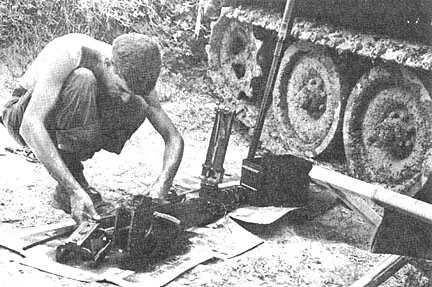 |
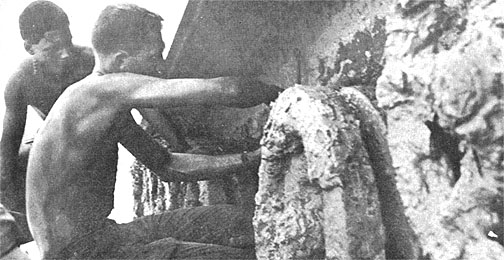 |
Page 8 TROPIC LIGHTNING NEWS June 8, 1970
Villagers Help GIs
PSYOPS Pays Off
CU CHI - Psychological operations conducted by Triple Deuce units in the
village of Nha Viec near here paid excellent dividends recently.
After learning of recent Viet Cong visitations in the area, the 2nd
Battalion, 22nd Infantry, Psyops team conducted an emergency MEDCAP in the
village.
Medicine, soap and a variety of Psyops leaflets were passed out to the
villagers. Also a number of Chieu Hoi passes were distributed and scattered
along the VC trail to and from the village.
“The villagers were fast to accept aid from our medics,” said 1st Lieutenant
Joseph Williams, S-5 from Goddman, Miss. “Real progress has been made in
winning the hearts of the people in Nha Viec.”
Kit Carson scouts, who serve as interpreters, mingled with the villagers
gathering intelligence on the enemy unit which had tried to enter the village
the previous evening.
“With the information we gained during the day we were able to set up an ARVN
ambush that night,” said Williams.
The ARVN’s scored four kills and four detainees, thanks to the villagers’
co-operation.
Sergeant John Glatfelter of York, Pa., Psyops NCO, said, “With our many ICAPS
and MEDCAPS, conducted daily around the Cu Chi area popular support from the
villagers is growing rapidly. The ambush was an excellent example of this.”
Rock Group Entertains Makeshift Standdown
FSB Devins - Upon receiving word that a long awaited Cu Chi Standdown had
been cancelled, members of the Wolfhounds could be described as somewhat
disappointed. Their chagrin was, however, happily short-lived.
Cause of the cancellation was the immediate re-deployment of Bravo and Echo
companies, 2nd Battalion, 27th Infantry, into Cambodia. This made the trip to
Cu Chi unfeasible. The situation, however, was soon corrected.
“We simply brought the standdown to them,” explained 1st Lieutenant Richard
Spencer, San Antonio, Tex. Refreshments included beer and soda. Entertainment
was provided by `The Mamals,’ a rock group from Manila.
“We saw the band perform at the NCO club a few nights before,” said Staff
Sergeant George Robillard of Trabucla Canyon, Calif. The band indicated a
willingness to perform for the men.
A makeshift bandstand, constructed under the roof of an abandoned mess hall,
was the scene of several hours of soul and hard rock as put down by the Manila
group.
The general consensus was that the entire event was a Definite success.
Specialist Four Bonnie Poe of San Francisco remarked that the ‘Mamals’ “were
number one. They played songs that everybody likes,” he said. Selections
included; ‘Light My Fire’, ‘Good Lovin,’ ‘In A Gadda Da Vidda,’ and ‘Gloria.’
After the group finished their performance the Wolfhounds pitched in to load
the musical equipment on the trucks heading back to Cu Chi.
Cambodians Get Medical Support
By SP4 BRAD YEAGER
FSB SHARRON, Cambodia - Members of the 1st Battalion, 27th Infantry’s S-5
(Civic Actions) section have begun conducting MEDCAPS with Cambodian villagers
near this 25th Division fire support base about two miles northeast of the
“Dog’s Face.”
Since arriving here May 11, the Tropic Lightning “Wolfhounds” have been
conducting two MEDCAPS and treating about 120 people a day.
Initially, the villagers were afraid of the GIs and reluctant to come
forward. This hesitance was overcome by the use of a Cambodian interpreter,
who, at each MEDCAP, singles out a spokesman from the village to explain the
intentions of the Americans.
“But within twenty minutes after using the speaker there was a big crowd
around the jeep. After seeing that we didn’t have any tricks up our sleeves,
the people became very friendly,” Maynor added.
The Cambodians soon were offering the Americans pineapples, coconuts and
other kinds of fruit - some of which the GIs had never seen before.
‘Hounds Give Ride to Refugees
By SP4 BRAD YAEGER
FSB SHARRON, CAMBODIA - Vietnamese refugees, forced from their homes by the
recent conflict in Cambodia, have been streaming into this small 25th Division
fire support base two miles inside Cambodia, northwest of the “Dog’s Face.”
Members of the 1st Battalion, 27th Infantry “Wolfhounds”, have been trucking
the refugees at the rate of 80 per day into Tay Ninh, RVN, where the government
of the Republic of Vietnam has set up a camp to provide for them.
“A few families came in first, spontaneously,” said First Lieutenant David
Lewis, Civil Administration officer with the 1/27th. “Then they asked whether
their friends could come, and soon there were dozens of people waiting to be
trucked back to Vietnam.”
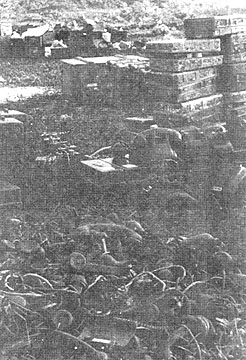 |
COMMO CACHE -- This jumble of headsets, wire and radio shells was part of an enemy communications cache uncovered by Alfa Company, 1st Battalion (Mech.), 5th Infantry. Included in the cache were telephones, radio receivers, generators, tape recorders and typewriters. (Photo by SP4 Rich Fitzpatrick) |
Helmet Covering Bears
GI Views
By SP4 ED TOULOUSE
FSB KEIN -- To the unimaginative person a camouflage cover is simply what its
name implies, a “see me no more” covering for a steel pot. To the average
“grunt” however, it’s real significance lies in potential as a creative media.
Almost everyone of us at one time or another has had the yearning to express
himself in an unorthodox fashion, whether it be as a prankster adorning a school
desk with works of art or performing similar functions on lavatory walls. The
camouflage cover, in a sense, also has proven to be a means to this end.
Found on the cover may be the owner’s social, political and moral views or
frustrations, the name of his girls, wife or home town or perhaps and itinerary
of his accomplishments while in Viet Nam.
The following are some of the more commonly used expressions: “peace,” “make
love not war,” “think snow,” “the Lord is my Shepherd,” “Freedom bird where are
you?” “ski Squaw Valley,” “Richmond Virginia - God’s country,” “short-285 days,”
“Peace through prayer,” “What if someone gave a war and nobody came?” “God is my
pointman.”
Private First Class Dan Kleven of Delta Company, 2nd Battalion, 12th
Infantry, an avid ski enthusiast from Willmar, Minn., when asked what “think
snow” means to him, responded: “It’s more of a satirical outlook on my present circumstances. It expresses
something that obviously cannot be realized here, but more importantly it’s
something to look forward to.”
Perhaps some of these slogans are familiar, maybe even your own. Generally,
they all seem to revolve around one main theme - “HOME.”
Stop Contraband
Lady MP’s Check Workers
By SP4 RICH ERICKSON
DAU TIENG - A military policewoman? In Vietnam?
Because an important role of the MPs in Vietnam is to provide supervision
over all civilians who daily enter base camps to work, the 25th Division Military
Police Corps at Dau Tieng employs three Vietnamese women.
They insure that no contraband is carried past the gate by female workers.
One of the women MP’s, 28-year old Thi Houl, has been working as an MP for
the past three years. She and her two assistants say they enjoy and take a great deal
of pride in their work. They check identification of female workers and
examine the items which the workers take in and out of the base camp.
Since Thi speaks English well, the MPs claim she has been invaluable as an
interpreter. She acts as a liaison between the civilians and the MPs.
Because Thi sees the same people every day, she relates, “I have no trouble
spotting a new face and check them carefully before they may enter the base.”
The job is not without its hazards, however.
“About a year ago I found $75 in MPC on a girl leaving the base compound and
took it from her. She hit me over the head. I had to be hospitalized for ten
days as a result,” Thi said.
“These girls help to iron out small problems before they get out of hand and
are really a great asset to us,” one MP added.
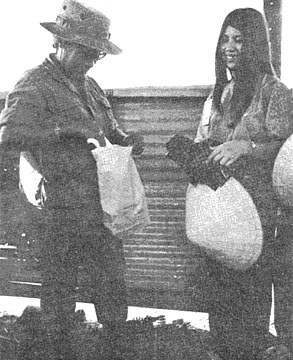 |
WOMAN MP -- The lady on the left is a woman MP at Dau Tieng. Thi Houl is responsible for checking workers such as this one in and out of the U.S. Base Camp and helps diminish the language problem by interpreting for military police. (Photo by SP4 Rich Erickson) |
Thanks to:
Robert Bessette, 3rd Bn., 22th Inf.,
for sharing this issue,
Kirk Ramsey, 2nd Bn., 14th Inf. for creating this page.
This page last modified 07-26-2005
©2005 25th Infantry Division Association. All rights reserved.